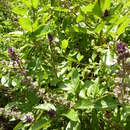en
names in breadcrumbs


Ocimum /ˈɒsɪməm/ is a genus of aromatic annual and perennial herbs and shrubs in the family Lamiaceae, native to the tropical and warm temperate regions of all 6 inhabited continents, with the greatest number of species in Africa.[2] It is the genus of basil and the name is from the Ancient Greek word for basil, ὤκιμον (ṓkimon). Its best known species are the cooking herb great basil, O. basilicum, and the medicinal herb tulsi (holy basil), O. tenuiflorum.
Ocimum species are used as food plants by the larvae of some Lepidoptera species including Endoclita malabaricus.
Known Ocimum species include:[2]
Most culinary and ornamental basils are cultivars of Ocimum basilicum and there are many hybrids between species. Thai basil (O. basilicum var. thyrsiflora) is a common ingredient in Thai cuisine, with a strong flavour similar to aniseed, used to flavour Thai curries and stir-fries. Lemon basil (Ocimum × citriodorum) is a hybrid between O. americanum and O. basilicum. It is noted for its lemon flavour and used in cooking.
Holy basil or tulsi (O. tenuiflorum) is a sacred herb revered as dear to Vishnu in some sects of Vaishnavism. Tulsi is used in teas, healing remedies, and cosmetics in India, and it is also used in Thai cooking. Amazonian basil (O. campechianum) is a South American species often utilized in ayahuasca rituals for its smell which is said to help avoid bad visions.[3] O. centraliafricanum is valued as an indicator species for the presence of copper deposits.
Ocimum /ˈɒsɪməm/ is a genus of aromatic annual and perennial herbs and shrubs in the family Lamiaceae, native to the tropical and warm temperate regions of all 6 inhabited continents, with the greatest number of species in Africa. It is the genus of basil and the name is from the Ancient Greek word for basil, ὤκιμον (ṓkimon). Its best known species are the cooking herb great basil, O. basilicum, and the medicinal herb tulsi (holy basil), O. tenuiflorum.